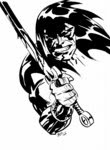Signature Shots: Spike Lee


I had a long internal debate about what to entitle this (hopefully) continuing series. Signature shots or "Irritating tics"?
Because the difference between the two seems to be minimal in many cases.
Take Spike Lee. He likes to use a dolly shot, which isn't uncommon, of course. Except he mounts his actor on the dolly so that they glide right along with the camera. In close up, generally, altough occasionally he'll set the actor a little further back in the frame. He is a serious Director and he has made, in my opinion, a few genuinely great films in Do The Right Thing, The 25th Hour and When the Levees Broke, and I don't believe this shot is just a flashy example of ostentatious directorial style, as it might be in some director's work. Its an extremely risky shot - so contrived and pronounced that it always seems a statement of sorts, a declaration of the directors presence in a way few other single shots equal. I think Lee uses it to signal that a character is in an altered state - either that they have reached a sort of enlightenment, that they are in a psychological or emotional fugue or that they are not truly present in their immediate reality. In Malcolm X, he uses it as Malcolm approaches the Aubudon, where he will be assassinated. Here it is as if Malcolm is walking to his own death, fully aware and paranoid, and not quite feeling the everyday act of strolling in the street as most men might.

Which is laudable. But Lee has used it too often. If I see it in a Lee film now, I groan. And invariably, I do see it in a Lee film. He seems unable or unwilling to refrain from using this shot for very long. He varies the angle (sometimes above, sometimes slightly below, sometimes eye level) and the length of the shot and the movement involved, but it shows up too often in his work. Its perhaps best utilised in The 25th Hour, where Lee's camera glides serenely around post 9/11 New york, a place in which everyone seems to be in some traumatised state of altered consciousness.
But it doesn't matter what approach the material demands - even in a piece of (admittedly good) hackwork like Inside Man, Lee can't resist. It almost feels as if hes doing it to keep himself amused...

The shot it most reminds me of is a Scorsese shot from Mean Streets, where he mounts a camera to Harvey Keitel's chest. A drunken Keitel then stumbles around a party, the camera recording his every twitch and guffaw, tied as closely to his face as it is, but also suggesting the chaotic, sickening abandon of his night out. The Scorsese shot feels a lot more organic and a lot less controlled, and hence draws less attention to itself.
But then Scorsese has always had a sort of genius for justifying a spectacular, showy shot thematically or narratively. its one of the elements that made him such a brilliant director in his early career. Spike Lee, for all of his admirable qualities, possesses no such genius, and his stylistic flourishes often seem just that.
Labels: cinematography, spike lee



2 Comments:
Terrific idea for a series, David.
My ability to tolerate Spike's signature dolly shot has to do with whether or not Anna Paquin happens to be riding the dolly.
Anna Paquin in just about any shot is a good thing, I've found...
Post a Comment
<< Home